Wizardry and Ultima were great inspirations for me. But I wanted to make my own vision for a CRPG. I wanted more of an open-world feel, with quests, puzzles, and an emphasis on exploration and discovery. I wanted party-based tactical combat, tons of magic items to find, and an ever-increasing feeling of power as you leveled your characters. Most of all, I wanted players to feel free to experiment with all of the “tools” I put in the game, so that they could enjoy playing any way they wanted to.
— Jon Van Caneghem
The long-running Might and Magic CRPG series is an easy thing for a project like this one to overlook. These games were never obviously, forthrightly innovative, being content to rework the same high-fantasy territory over and over again. Meanwhile their level of commercial success, although certainly considerable at times, never became so enormous as to make them sit up and demand our attention.
What Might and Magic consistently did have going for it, however, was the quality of being fun. Jon Van Caneghem, the series’s guiding light, was himself a lifelong compulsive gamer, and he stuffed his creations full of the things that he himself enjoyed: quests to fulfill, dungeons to explore, loot to collect, and an absurd variety of monsters to fight, all couched inside a non-linear, open-ended philosophy of gameplay that eschewed the sort of (overly?) elaborate set-piece plots that had begun to mark many of his series’s peers by the dawn of the 1990s. Might and Magic games, in other words, weren’t so much stories to be experienced as places to be explored.
Chet Bolingbroke — better known as The CRPG Addict — names “generous” as his defining adjective for Might and Magic.
The Might and Magic games have always been generous. Jon Van Caneghem clearly had a history with tabletop RPGs and early CRPGs, but he envisioned worlds of bounty where those titles were sparse and unyielding. In Wizardry, Might and Magic’s most obvious forebear, a 16 x 16 map might only hold a couple of fixed combats and two textual encounters. Van Caneghem’s strategy was to give you something in every row and column. I have maps from the first game in which I had to go into the double letters to annotate everything. A Dungeons & Dragons module might take you from Level 2 to 5 over the course of 30 hours of campaigning. Van Caneghem had no problem offering games in which you hit Level 100 or more. Where Dungeons and Dragons and Wizardry regarded attributes as closely policed within a 3-18 range, you might start at 15 strength in Might and Magic and end at 500.
Throughout its long history as a series, Might and Magic never strayed far from this gonzo approach. It remained always that which it had first aspired to be: an exercise in exploring spaces, killing the monsters you met there, and taking their stuff so that you could use it to kill even tougher monsters somewhere else. But within that template, it did find room to innovate — to do so, in fact, in more ways than it’s generally given credit for, including a few innovations that have become staples of the CRPG genre today. If it was no poster child for games as art, it had arguments of its own to make for games as pure fun.
Jon Van Caneghem was in some ways the last of a breed: the last of the living-room gaming entrepreneurs who dominated at the very start of the industry, with their self-coded products, their homemade packaging, and their naïve gumption that took the place of business plans and venture capital.
Van Caneghem grew up as a child of privilege in the 1970s near the heart of Hollywood, the stepson of a prominent neurologist. His parents had high ambitions for him; he attended grade school at the elite bilingual Lycée Français de Los Angeles. But he never quite fit the mold his parents had cast for him. A slow reader and reluctant student, he was obsessed with games from a very young age, beginning with checkers, then moving on to chess, Risk, and Diplomacy, then to Avalon Hill’s wargames and finally, inevitably to Dungeons & Dragons. He entered UCLA as a pre-med student in 1979, but becoming a doctor was his parents’ dream for him, not his own. Once there, he continued to devote the bulk of his energies to playing games, as well as another, more dangerous obsession: racing cars on the legendary Mulholland Drive.
Van Caneghem discovered computers and computer games during his middle years at university, just as many of his friends were finding jobs and significant others, and were left with less time for game nights as a result. “Then a friend of mine showed me an Apple II, and he was playing a bunch of simple games on it,” he remembers. “This was great! I could play any time I wanted and didn’t have to wait for anyone to get together. So, I immediately got one.”
Like at least half of the Apple II world at the time, he was soon in the throes of a full-blown Wizardry addiction; he guesses he must have finished it “seven or eight times.” The original Ultima also consumed plenty of hours. It was ironically the flaws in these pioneering but technologically limited early CRPGs that drove him to go from being a game player to a game maker.
Everyone started to tell me, “You’re always complaining about these games. Why don’t you make your own?” And I said that I didn’t have the slightest idea how to program. But it intrigued me. I switched from being a pre-med student to a math and computer-science major at UCLA and just started delving into the Apple II, absorbing every magazine and piece of information I could find. Everything I was learning at school was just ancient history as far as the computer was concerned, with punched cards and mainframes. There was nothing about personal computers. So I pretty much had to teach myself everything.
Much to his parents’ relief, he finished his Bachelor’s program at UCLA in 1983, albeit not in the major they had planned for him. Then he dropped a bombshell on them: he wanted to make his own computer game and sell it. They reluctantly agreed to give him a couple more years of room and board while he chased his dream.
In the end, it would take him almost three years to make the grandiosely titled Might and Magic: Book One — The Secret of the Inner Sanctum. In what Van Caneghem still calls the most satisfying single creative experience of his life, he designed and programmed the whole thing himself. He drew the graphics with some help from a pair of outside artists he hired, and outsourced some of the writing to his wife. But at least 90 percent of the sprawling final product was his work alone.
When he began to shop the game around to publishers at last in 1986, he found they were very interested; CRPGs were enjoying a boom at that time, with Ultima IV and The Bard’s Tale having been two of the biggest hits of the previous year. Yet he was sadly underwhelmed by the terms he was offered, which might allow him to earn $1 per copy sold at a retail price of $35 or more.
So, having come this far alone, he decided to self-publish his game. Being a self-described “ultimate Star Trek nut,” he chose New World Computing — as in “strange new worlds and new civilizations” — for the name of his new company. He recruited friends to draw the art for a box and a rather handsome map of his game’s land of Varn, then bought himself a PO Box and a toll-free order line along with advertisements in Computer Gaming World and A+, respectively computing gaming’s journal of record and one of the most popular of the Apple II magazines. Having been taught from a young age that success in life often hinges on looking like a success, he pulled out all the stops for the advertisements. Instead of the quarter-page black-and-white ad with fuzzy stick-figure art that was typical of home-grown software entrepreneurs like him, he convinced his parents to splash out one more time for a professionally laid-out, full-page, full-color spread that looked as good as any of those from the more established competition and better than most of them; this was an advertisement that couldn’t help but get Might and Magic noticed.
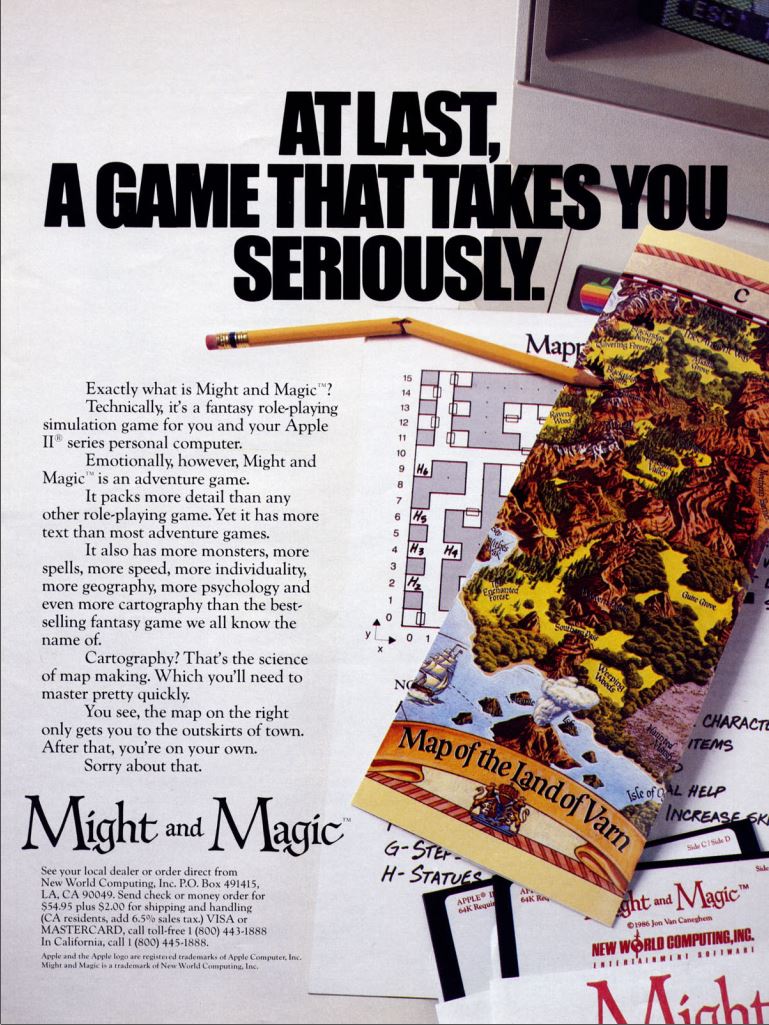
The first Might and Magic advertisement, which came complete with veiled jabs at The Bard’s Tale. It’s amusing to see how it describes pencil-and-paper map-making as a virtue rather than a necessary evil. Most gamers apparently didn’t agree: the very next game in the series would feature one of the CRPG genre’s first simple auto-maps.
And it did get noticed: it was a case of the right game at the right time putting its best foot forward, and the response exceeded all of his expectations. The order line which he’d installed in his bedroom rang all night long, and Van Caneghem, who had no intention of missing a single sale, turned into a sleep-deprived zombie thanks to it. Relief came in the form of another phone call, this one from Jim Levy, the CEO of Activision. Levy explained that Activision was starting something they called an “affiliated-label program” to help small developers get their products to market, and he thought that New World Computing would be an excellent candidate. (He may have been motivated to atone, to Activision’s stockholders if no one else, for his infamous rejection of Interplay’s The Bard’s Tale as “niche-ware for nerds” — a rejection which had delivered to Activision’s arch-rival Electronic Arts their biggest hit to date.) Activision could take phone orders and, much more importantly, distribute Might and Magic to stores all over the country, all while taking a smaller cut than a traditional publisher and leaving the New World logo as the only prominent one on the box; they could even put Van Caneghem in touch with people who could port it to other platforms. It sounded very good indeed to the young entrepreneur.
Within weeks of this conversation, Levy was fired from Activision, but the deal he had made with Van Caneghem remained in place. Might and Magic‘s arrival in stores in early 1987 was heralded by a glowing review in Computer Gaming World from Scorpia, the magazine’s longstanding adventure and CRPG columnist. She called it “world touring on a grand scale”: “There is so much to learn and enjoy in Might and Magic because its scope and complexity are amazing.” Ports to the IBM PC and Commodore 64 were available well before the Christmas of 1987. While it would never quite manage to join Ultima, The Bard’s Tale, and, soon, Pool of Radiance and the other SSI Gold Box games in the very top commercial tier of late-1980s CRPGs, it did become the leading name among the second tier, more than enough to get New World off the ground properly and create high expectations for a sequel.
Despite Scorpia’s rapture over it, this first Might & Magic game was, like all of the ones that would follow it, disarmingly easy to underestimate. It wore the influence of Wizardry and its successors, The Bard’s Tale among them, prominently on its sleeve: it too was an exercise in turn-based, grid-based exploration, which you navigated from a first-person point of view despite controlling a party of up to six characters. (The oddity of this has led to its sub-genre’s modern nickname of “blobber,” for the way it “blobs” all of your characters together into one octopus-like mass of sword-wielding arms and spell-casting hands.) Its technology verged on the primitive even in 1987, the year which saw the introduction of real-time gameplay to the CRPG genre in Dungeon Master. Nor was it any paradigm of balanced design: the early stages, when your newly created party consisted of naked, penniless club-wielders, proved so difficult that Van Caneghem grudgingly added a slightly — slightly, mind you — more hardy pre-made starting party to later releases. Even once your characters made it to level three or so and were no longer as weak as infants, the difficulty level remained more jagged than curved; monsters could suddenly appear on some levels that were an order of magnitude more powerful than anything else you’d met there, killing you before you knew what had hit you. This was an especial problem given that you could only save your game from one of the nine adventurer’s inns scattered around the sprawling world, a result more of technical limitations than designer intent. Meanwhile the story was mostly nonexistent, and silly where it did exist, culminating in the revelation that the entire world of Varn you’d been exploring was really a giant artificial biosphere created by space aliens; “Varn” turned out to be an acronym for “Vehicular Astropod Research Nacelle.”
If you could get past all that, however, it was a surprisingly rich game. Caneghem has noted that, though he became a pretty good programmer in the course of making Might and Magic, he was always a game designer first, a game programmer second: “I wasn’t a programmer who knew a neat graphics routine and then turned it into a game. I think most people at the time, except for a few, came from that end of it.” As one of the few who didn’t, Van Caneghem took a more holistic approach. Here we have to return to this idea of generosity that the CRPG Addict broached for us at the beginning of this article. Primitive though it was, Might and Magic was still crammed to bursting with stuff, enough to fill a couple of hundred hours if you let it: 250 different items to collect, 94 different spells to cast, 200 different monsters to fight, 55 individual 16-square-by-16-square areas to map. It boasted not only dungeons and towns, but a whole grid-based outside world to explore. The lumpy amalgamation was riddled with cheap exploits as well, of course, but discovering them was half the fun. One should never dismiss the appeal of building a group of adventurers from a bunch of babes in the woods who fall over dead if a goblin looks at them sideways to a six-person blob of terror that can annihilate a thousand of the little buggers at the stroke of a key.
For all its manifest derivativeness in the broad strokes, Might and Magic wasn’t without a smattering of genuinely new ideas, at least one of which became quietly influential on the future course of its genre. As you explored its maps, you often met people who gave you quests: tasks to accomplish apart from revealing more territory and collecting more experience points. These could range from such practical affairs as delivering a letter to another town to more, shall we say, whimsical endeavors, such as climbing every tree in a given area. Completing these side-quests provided rewards in the form of additional experience points and riches. More importantly, it added an additional impetus to your wanderings, a new dimension of play that was different from methodically lawn-mowering through a sometimes numbing procession of dungeons and monsters. In time, sub-quests like these would become an essential component of many or most CRPGs.
Jon Van Caneghem took advantage of his first game’s success to set up a proper office for New World in Van Nuys, California, and hire a staff made up of people much like himself. “A lot of our employees had met at game conventions, and all of our roots were in gaming,” he says. “At 5:30, the office would shut down and the gaming would start. Everyone was always there until all hours of the night, playing games.” He noted in a contemporary magazine profile that he wished above all to keep the New World offices “loose, friendly, and creative.”
He and his fellow travelers shipped Might and Magic II: Gates to Another World in December of 1988. Although clearly of the same technological lineage as its predecessor, it was a big step forward in terms of the details. Not only did it offer an even vaster profusion of stuff, spread over 60 different discrete areas this time, but it came with some significant quality-of-life improvements, including a reasonably usable auto-map if you chose to invest in the Cartography skill for at least one of your characters. Another subtle but welcome improvement came in your ability to set a “disposition” for your party, from “inconspicuous” to “thrill-seeker”; this allowed you to set the frequency of random monster encounters to your own liking, depending on whether you were just trying to get someplace or were actively grinding for experience points. But the most obvious improvement of all was the revamped graphics, courtesy of the full-time artists Van Caneghem had now hired; a version for the Commodore Amiga, the audiovisual wundermachine of the era, looked particularly good. The story was as daft as the last one, taking place on another world… err, alien biosphere called Cron instead of Varn. (The stories of Might and Magic do rather tend to satirize themselves…) But, just like last time, it really didn’t matter at all in a game that was all about the joy of exploration and exploitation.
The improved audiovisuals of Might and Magic II highlighted another aspect of the series that had perhaps been obscured by the primitiveness of the first game. In keeping with Van Caneghem’s sunny, optimistic personality — writer and designer Neal Halford, who came to work with him at New World during this era, calls him “terminally mellow” — the environs of Might and Magic would always be bright, colorful, fun places to inhabit. The series would never embrace the “dark, gritty” aesthetics that so much of the games industry came to revel in as the 1990s wore on.
Jon Van Caneghem the businessman seemed to live a charmed life not out of keeping with his vaguely fairy-taleish visual aesthetic. For instance, he dropped Activision in favor of becoming an affiliated label of Brøderbund in 1989, just before the former company — by this point officially known as Mediagenic — imploded, defaulting on their payments to their entire network of affiliated labels and destroying many of them thereby. He even escaped relatively unscathed from a well-intentioned but financially ill-advised venture into the board-game market, which I’ll cover in more detail in my next article.
For now, though, suffice to say that it was a big part of the reason that Might and Magic III: Isles of Terra wasn’t released until 1991. Like its predecessors, this latest entry in the series tossed you into another new world and let you have it. Still, while philosophically and even formally identical to the first two games — it remained a turn-based, grid-based blobber — it was a dramatic leap forward in terms of interface and presentation. Designed on and for a 32-bit MS-DOS machine instead of the 8-bit Apple II, it sported 256-color VGA graphics that replaced many of the older games’ numbers with visual cues, a lovely soundtrack composed for the new generation of multi-voice sound cards, and a mouse-driven interface. But its most gratifying improvement of all was more basic: it finally let you save your progress inside dungeons or anywhere else you liked. I would venture to guess that this change alone cut the number of hours the average player could expect to spend finishing the game in half, in spite of the fact that its number of individual areas actually grew slightly, to 64.
Veterans of the series could and sometimes did complain that the new level of professionalism and polish came at the cost of some of its old ramshackle charm, and Van Caneghem himself has confessed to being worried that people would notice how the new game’s average completion time was more likely to be in the tens than the hundreds of hours. But he needn’t have been: gamers ate it up.
In his review for Computer Gaming World, Charles Ardai captured how impressive Might and Magic III was in many ways, but also made note of the ennui that can come to cling to a series like this one — a series which is dedicated to doing the same thing better in each installment rather than doing anything dramatically, holistically new.
Unfortunately, Might and Magic III is also a remarkable exercise in water-treading, which does not advance the genre one inch in terms of plot, event, or ontology. Here we are again, one realizes, a band of hardy adventurers — elves, gnomes, dwarves, clerics, paladins, sorcerers — tramping about the wilderness and facing off against assorted orcs, rats, bugs, and other stock uglies.
Here we are, once more mapping a corner of Middle-earth, or a reasonable facsimile thereof, in pursuit of yet another necromatic ne’er-do-well with a faux-mythic name and a bad disposition. Here we are again — will we never be somewhere else?
On the other hand, there is a market for this stuff. David Eddings rewrites the same high-fantasy novel over and over again and never fails to hit the bestseller lists with it…
Ardai concluded that “the gamer who wants to be surprised by discovery, conversation, and story is likely to be disappointed in Might and Magic III, while the gamer who simply wants to play [emphasis original] may be ecstatic with the game.” Few sentences sum up the Might and Magic series as a whole more cogently.
The next pair of games in the series pushed the boundaries in terms of size without even attempting to address Ardai’s complaints. (After all, if it worked for David Eddings…) The name of 1992’s Might and Magic: Clouds of Xeen reflected a sudden games-industry conventional wisdom that numbered titles could actually be a drag on sales, being a turn-off to the many folks who were acquiring home computers for the first time in the early 1990s. “I felt strongly that everyone wants to see the next James Bond movie, but no one wants to see Rocky IX,” says Van Caneghem. “So off came the numbers.” This sentiment would die away as quickly as it had flared, both inside and outside of New World.
Both Clouds of Xeen and the would-be Might and Magic V, which was known simply as Might and Magic: Darkside of Xeen upon its release in 1993, took place, as you might have guessed, in yet another new land of adventure known as Xeen. More interestingly, when combined they represented another of New World’s subtle experiments with the nuts and bolts of the CRPG form if not the substance. If you installed them both on the same computer, they turned into World of Xeen, a single contiguous game encompassing no less than 201 discrete areas. Outside of its central gimmick, World of Xeen continued the Might and Magic tradition of careful, compartmentalized evolution. It was, for example, the first CRPG I know of that included an automatic quest log as a replacement for the dog-eared, hand-written notebooks of yore. It also added a global difficulty setting. Van Caneghem:
I added a feature when you first start the game where you’re asked if you want an Adventurer game or a Warrior game. This was my wife’s idea. She really liked the game, the adventure. But she wasn’t into combat. She was like, well, you know, monsters are fun, but let’s get on with the story. I said, “Okay, well, I’m sure there’s plenty of people out there just like you, who aren’t into the numbers and the hit points. They just want to get on with the story.” There’s a lot of quests, a lot of fun things to do. So I put the choice in, and what Adventurer does is it makes it easier to win all the battles. So you get through that part of the game a lot quicker.
There’s other stuff to do, and we want to expand our audience, to bring in more and more people who wouldn’t normally play this kind of game.
But this notion of “expanding our audience” was becoming a sticking point for Might and Magic by the time the conjoined World of Xeen appeared in the inevitable single box in 1994. Some of Charles Ardai’s criticisms appeared to be coming home to roost; the market had been flooded with fantasy CRPGs over the last half decade, most of which appeared all but indistinguishable from one another to the casual browser. It was extremely difficult even for a well-done example of the form, such as Might and Magic had always been on the whole, to stand out from the competition. The new generation of gaming neophytes to whom Van Caneghem imagined his Adventurer mode appealing didn’t have the likes of Might and Magic and its peers on their radar at all; they were buying things like The 7th Guest, Myst, and Phantasmagoria. The CRPG genre had transitioned from boom to bust, and was now deeply out of fashion.
This reality left Jon Van Caneghem and his company facing some hard questions. The engine which had powered the last three Might and Magic games was several years old now, its once-impressive VGA graphics looking a bit sad in comparison to the latest high-resolution Super VGA wonders. Clearly it would need to be rethought and rebuilt from scratch for any possible Might and Magic VI. But was there really a business case for taking on such an expensive task in the current market? Or had the franchise perhaps run its course, as such venerable rivals as Wizardry, The Bard’s Tale, and Ultima seemed to have done?
Van Caneghem’s solution to this dilemma of what was to be done with a respected CRPG franchise in an era when CRPGs themselves seemed to be dead on the vine would prove as unexpected as it would refreshing, and would spawn a great rarity in gaming: a spinoff franchise that became even more popular than its parent.
(Sources: the book Might and Magic Compendium: The Authorized Strategy Guide by Caroline Spector and the individual hint books published by New World Computing for each of the first five Might and Magic games; Compute! of May 1993; Computer Gaming World of December 1986, April 1987, October 1988, March 1989, May 1989, May 1991, January 1992, September 1993, and April 2004; Retro Gamer 49; XRDS: The ACM Magazine for Students of Summer 2017. Online sources include the CRPG Addict’s final post on Might and Magic: Darkside of Xeen, Matt Barton’s interviews with Jon Van Caneghem and Neal Hallford, and the RPG Codex interview with Jon Van Caneghem.
The first six Might and Magic CRPGs can be purchased as a digital bundle at GOG.com.)
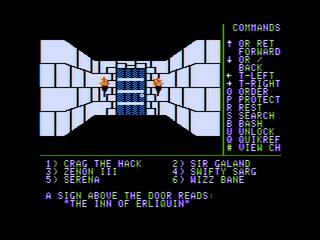
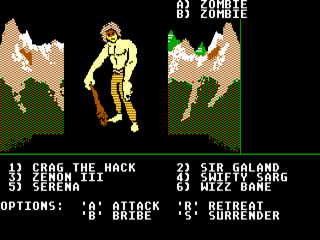
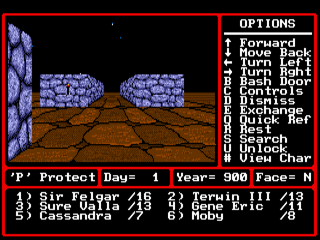
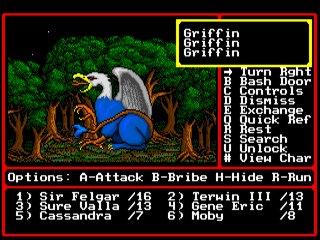
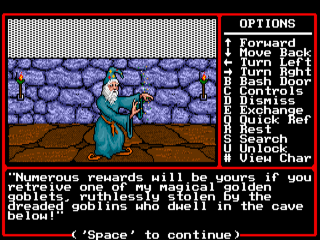
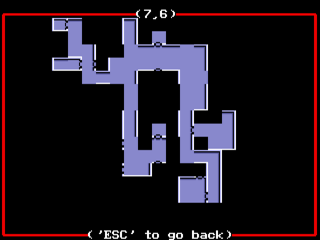
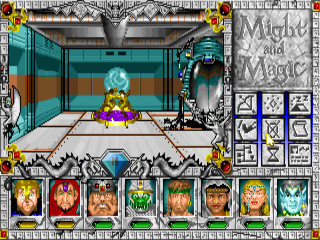
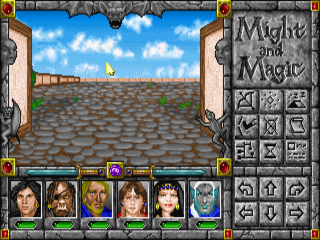
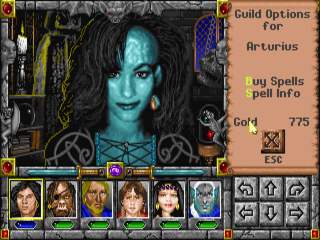
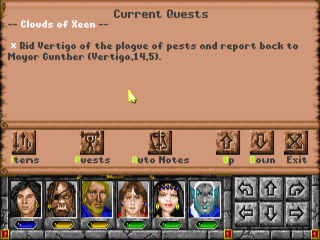










Aula
December 10, 2021 at 5:30 pm
“a virtue rather a necessary evil”
rather than
“turned-based”
turn-based
“this allowed you set”
to set
Jimmy Maher
December 10, 2021 at 8:58 pm
Thanks!
morg
December 11, 2021 at 1:01 am
also a “Cangehem” in there
Jimmy Maher
December 11, 2021 at 7:24 am
Thanks!
Alan
December 10, 2021 at 7:12 pm
The only one I seriously played was Xeen. It’s been a long time, but I remember finishing Clouds and at least dabbling in Darkside. And I remember having a preposterous amount of fun, a huge, vibrant, and slightly goofy world. I also loved the lists of adjectives that modified weapons and armor, leading silliesness like a “glass sword” being superior to a “steel sword” (from memory). Since I learned that ScummVM had added support, I’d been meaning to take it for a new spin.
Sniffnoy
December 10, 2021 at 8:14 pm
Oh, heh, before Sonic & Knuckles, even. :)
Brian
December 10, 2021 at 9:58 pm
I downloaded M&M from GOG a few years ago having never played it back in the day and enjoying working my way through the first few areas… have been meaning to get back to it!
Funny though at the mention of David Eddings above… I just fell for and started rereading The Belgariad last week. Along with some other bad fantasy and sci-fi from that time.
Alex Freeman
December 10, 2021 at 10:07 pm
What’s so wrong with the plot twist that Varn is a giant artificial biosphere? I think that’s a clever way to distinguish it from the usual fantasy RPG.
Plot twist
December 10, 2021 at 11:17 pm
@alex freeman mainly I think because as a plot twist it was a cliche even then.
Alex Freeman
December 11, 2021 at 10:27 pm
Really? What stories or games before M&M used that plot twist?
whomever
December 11, 2021 at 11:26 pm
Alternate Reality, for one, a very interesting series of games from the mid 80s that Jimmy didn’t cover (cos he can’t cover them all).
https://en.wikipedia.org/wiki/Alternate_Reality:_The_City
Martin
December 12, 2021 at 12:24 am
A rather fun story was actually penned by Alan Moore in the UK comic 200AD in 1977. It was only as two pager but the basic concept was that large ants kept a glass box of oblivious humans and watched them fight it out as kids might watch an ant farm colony work. The final ‘shock’ panel is in this following link:
https://1.bp.blogspot.com/-ppN3ywUvVoI/Ut9ehyMH_KI/AAAAAAAAD30/AvYUMhMGtzI/s1600/025+p18+thargs+future+shocks.jpg
eobet
December 12, 2021 at 3:28 pm
Did you know that Bonita Long-Hemsath did the graphics for both Alternate Reality and the Might & Magic games? It’s rare that someone mentions Alternate Reality, and even rarer that anyone mentions her (she unfortunately died a year or so ago, I’ve heard from someone who worked with her).
Also, did Wizardry do the space theme mixed with fantasy before or after Might & Magic?
Jimmy Maher
December 13, 2021 at 8:17 am
I don’t think Wizardry pulled the “it’s really a spaceship!” stunt until Bane of the Cosmic Forge in 1990.
Patrick Smith
December 12, 2021 at 5:15 pm
My brother and I owned the first Alternate Reality game. It seemed quite cool (it even had it’s own theme song, with lyrics!) but the frustrating thing was, you couldn’t do a whole lot because going anywhere outside the City required one of the other games (if memory serves me, there was a Dungeon below the city we couldn’t enter.) I don’t remember if those games just weren’t out yet, or if we simply didn’t buy them, but it made for a curiously truncated experience.
arthurdawg
December 16, 2021 at 5:57 pm
https://en.wikipedia.org/wiki/Alternate_Reality_(series)
The Dungeon was released, although it was intended to be a part of the original game.
Interesting history!
stepped pyramids
December 12, 2021 at 12:26 am
The “secret worldship” storyline goes back well into the mid 20th century, but most relevant to Might & Magic is probably the Star Trek episode “For the World Is Hollow and I Have Touched the Sky”, which features a primitive civilization in a worldship disguised as an asteroid:
https://en.wikipedia.org/wiki/For_the_World_Is_Hollow_and_I_Have_Touched_the_Sky
I believe there’s a name drop of this episode either in this game or one of the sequels. Harlan Ellison also worked on a 1973 series called The Starlost, which is even closer — a huge generation ship consisting of many biospheres that were isolated from each other in the distant past.
That said, I don’t think the twist is itself bad because it had been done before. The issue with the twist is that it’s literally the last thing that happens in the game and has virtually nothing to do with the plot.
Kyle Haight
December 10, 2021 at 11:28 pm
I still have my Apple copies of the first two games in the series, and fond memories of mapping them out on graph paper. The second one is also the only game I remember that used the Apple’s extended high resolution graphics mode. It looked great at the time.
Tim Kaiser
December 11, 2021 at 6:00 am
I’m a huge fan of the Might and Magic series. Reading those quotes from the Jon Van Caneghem and the CRPG Addict put a smile on my face in helping me remembered why I enjoyed playing them so much. And the goofy fantasy/sci-fi story is a unique aspect to the series as well.
James McNeill
December 11, 2021 at 1:18 pm
I loved these games. The scale of player-character power growth was ridiculous: ridiculously fun, that is. I remember drinking barrels of color-coded liquids that would raise a stat permanently. After running into several of them in one of the early dungeons I started to realize what the trajectory of my numbers was going to be over the course of the game and being somewhat gobsmacked. This becomes even more apparent in M&M 6, where an area that takes laborious effort to clear of enemies at the beginning of the game can be dealt with via a meteor strike or two by the end.
Another example of the games being fun first: in one of them there is a dungeon laid out as a crossword puzzle.
The art style was definitely its own thing too. I always described it as using every crayon in the box with favor toward none.
Leo Vellés
December 11, 2021 at 11:00 pm
In the text below the photo of the first M&M ad there is a double “would”
Jimmy Maher
December 12, 2021 at 8:28 am
Thanks!
Martin
December 11, 2021 at 11:34 pm
There does seem to be a discussion about the ending which I don’t want to interfere with so I’ll my part about it here instead.
I haven’t played the game(s) before and I’m unlikely to invest the 200 hours of play to find these details out, so let me ask them anyway.
– I don’t know how the game got to the biosphere ending but were there any clues along the way which with hindsight made it obvious or at least logical?
– Did it need the biosphere ending or had other things been tided up by then? Was it just an extra shock ending?
– Did the game do anything with the knowledge that at least one person knew about the aliens and their biosphere and did that action fit in with the rest of the game.
My personal views of the alien biosphere (or ant farm in the biology class) kind of twist is that you have to do something with it or you shouldn’t include it. If we assume that the aliens are so advanced compared to the people of Varn, what can the people of Varn do about it when they actually find out? If nothing, then why bring it up? If something, then how could a person of Varn advance so much to be able to even interact with them let alone challenge them?
On both of these, I am again assuming that something has to be done about these aliens for some reason because again, if the people of Varn are OK about being a research project of the aliens, why bring it up again?
Would be interested to here other opinions about this type of ending and if it has ever been used well in a game.
stepped pyramids
December 12, 2021 at 12:15 am
(Spoilers for Might & Magic I: The Secret of the Inner Sanctum follow.)
M&M I starts you off in the world of Varn with absolutely no plot or goal. The manual says “the object of an adventure game is the game itself, rather than a particular goal”. The only real hint to an ultimate objective is the title of the game. In the course of the game, you discover vague hints that the King of Varn is not who he appears to be. You also encounter a group of stranded aliens (like, Greys who say “eep oop!”) who, if approached properly, will warn you that they’re seeking out another alien who is impersonating a noble of Varn. It’s possible to miss both of these hints, but if you systematically explore every map you’ll eventually find the actual King, who will give you an item to break the impostor’s illusion. When you do that, the impostor will banish you into the “Soul Maze”, where you must find his true name in the walls (literally spelled out in walls on the map) before you can escape. When you do, after a bunch of unexplained sci-fi babble, you’ll find the original King is back on his throne, and he tells you to seek out the Inner Sanctum. To do _that_, you travel to the “Astral Plane” multiple times, each time unlocking more of the way to the Inner Sanctum. When you finally reach it, you encounter the caretaker of the Sanctum, and the titular “Secret” is “hey, this whole place is a big spaceship, and by making it here you’re eligible to transfer off the ship to a new world”. Then you go do that, game won, see you in M&M II.
So, to answer your question, the nature of Varn as an artificial biosphere is never really important in the game. Nobody in the game reacts to the discovery. It’s certainly never depicted as a bad thing (the people who created Varn are implicitly the good guys in the series). You never revisit Varn again for the rest of the series. Indeed, a lot of individual details about Varn and the aliens end up being ignored or contradicted by the rest of the series. The alien impersonator plot isn’t actually meaningfully connected to the “Varn is a spaceship” revelation, other than that resolving one is necessary to reach the other.
Chet Bolingbroke
December 15, 2021 at 6:08 pm
To add to this answer, stepped pyramids already noted that the source of the game’s revelation is the Star Trek episode “For the World is Hollow and I Have Touched the Sky.” That very phrase is etched in the wall of a castle where the real king is imprisoned, so that’s a bit of a clue.
Nate
December 12, 2021 at 6:18 am
“an especial problem” — did you mean “special”?
Jimmy Maher
December 12, 2021 at 8:25 am
As intended, thanks. (“Especial” lives in a place somewhere between “special” and “particular…”)
Manuel
December 12, 2021 at 12:59 pm
Thanks for the new word! I’m originally Spanish, and sometimes you block certain English words that look too close to Spanish like Especial.
I thanks to the writter, I never got into these games when I was a child, but I loved reading about the world’s in the magazines of the 80s, and this article brought me back there.
Thanks to everyone in the comments section and of course the writer of the article!?
Kromz
December 12, 2021 at 9:18 am
One of the best rpgs ever.
Such good written lore.. mm6 to 8 is so …uncomperble to anything.
Best ever.
Mmmerged is still very much a thing .
It has big communitys and i wish we had a decent continuation of it.
Mm9 and legacy pale in comparison.
GeoX
December 12, 2021 at 10:55 pm
I’ve actually beaten every Might & Magic from I through VIII (the post-New-World-Computing games never seemed worth bothering with). How about that? Nothing else to say. Just that I’m a fan. Also, man, I really wish they had used that VI-VIII engine for another game. I know people complained, but I thought it was SO SOLID. It’s just to bad that VIII, for entirely unrelated reasons, isn’t very good.
Chris Floyd
December 13, 2021 at 1:23 am
I feel like you glossed over the physical map a bit too quickly. I know Ultima had beautiful cloth maps too, but the M&M map was especially beautiful, I thought, and oddly informative? Like, there were four big beasts shown on the map, as I recall, and they seemed like “Here Be Dragons” kinds of decoration, but they actually pretty accurately showed you where you could encounter four key bosses. Other map features like mountain paths and desert bluffs clearly reflected the shape of the gridded sectors, too.
Those grid sectors were kind of ingenious, too. They made exploring the sweeping open world seem achievable. You knew when you’d seen everything in a sector, and hints about secret passages, etc, would emerge as you mapped them out–there was rarely any dead space, as I recall, you just had to find the way in. (When you did some uber-tough monster would destroy you, often.) Maybe all that was standard in Wizardry and Bard’s Tale… I could never get very far in those. Might & Magic always felt less oppressive, less gated.
Chet Bolingbroke
December 15, 2021 at 6:00 pm
Brilliant article as always. This filled in a lot of the gaps in my knowledge about Van Caneghem’s early years and the founding of New World. I look forward to the next installment!
Christopher G
December 15, 2021 at 6:35 pm
I don’t know why, but RPGs are so resonant, so timeless, I love reading about all of them, no matter whether I played them or not – Might & Magic is one I did play, and adored.
I’d love to hear about VI and beyond, and Heroes (another amazing series).
Sietse Wijker
December 26, 2021 at 8:11 pm
I started playing Might and Magic 7 with a friend. He always had stories how awesome Might and Magic 6 was. I remember his father going into an area with devils and shooting them with a laser gun.
Might and Magic 7 still defined my taste for RPG’s in general. The opening quest on the island, the hill fortress of the orcs, where you could shoot them with a cannon, the caves with troglodytes, the castle with giants, the mines with medusas.
I loved the system with the different magic guilds: fire, water, air, earth, body, soul, and mind. And I am still amazed by the upgrades for classes. I don’t remember it exactly, but I thought you could go from scout to ranger to hunter or something, with some really cool quests.
My friend was exploiting the way to level up by sneaking in and getting some quest items faster. His father said:
“It is called Might and Magic Peter, not Stealth and Sneak.”
I had MM8 myself, and while it was certainly entertaining. Playing as a dragon or vampire brought some new flavour. I really loved spamming meteor shower on my enemies. But I don’t remember that much else.
All the games I played after never scratched that same itch completely. Morrowind came close, but missed the charm of the Might and Magic universe, the cohesiveness of it’s own mythology.
Rowan Lipkovits
January 11, 2022 at 8:38 pm
Getting caught up on these articles, I can see the winds blowing toward the HOMM series for the “What would be next for New World when the formula grew stale?” question this one ends on… but it’s worth tossing a footnote to Catware’s Swords of Xeen, one of the first “total conversion” fan modifications to successfully go commercial. Maybe the reviewers had had enough of what M&M had to offer, but clearly the fans had not yet 8)
Andy M
April 14, 2022 at 11:02 pm
Thanks for the great article. I have a soft spot for games of this type, maybe because MM1 was the first CRPG I ever played (at the impressionable age of 9). It was massive and mysterious and undirected and packed to overflowing with STUFF, and I absolutely loved it. If they still made games like that, I would probably still play them today. :-)
Andrew
May 16, 2022 at 11:35 am
Loved this article.
I first purchased Might and Magic III from a pawn shop back in the early 2000’s (2003?) for the SNES. It was one of the only games I could afford, but it came to be one of the best choices I’ve ever made. It turns out to be most likely my favorite game of all time.
MMIII was difficult to learn as I had no manual or experience with these crawler types of games, but after a while I got used to it. Unfortunately, the SNES version is riddled with bugs, including some minor game-breaking ones like being unable to raise the personality stat and randomly finding millions of gold in random places.
Since then, I’ve played MM 2, 4, 5, 6, 7, 8, 9, 10, and the fan-created game Swords of Xeen. The best in the series is 3-7, with most people probably enjoying 6-7 the most. Or 4 for the more dated and retro cRPG experience.
Nic Allen
June 9, 2022 at 10:43 pm
Articles like this is why I keep coming back to the blog. You did a great job explaining reasons why I think I always liked Might and Magic over its contemporaries, in particular it’s brighter and more open ended nature.
As a relatively younger gamer to others likely here, I did not play PC games until the early 90s and then I did not play RPGs of any kind until the late 90s, but Might and Magic VI was the first game of its kind I played any substantial amount of, and still go back to play on occasion.
That being said, I went through a phase after playing the original Etrian Odyssey on the Nintendo DS, where I’d try any ‘blobber’ I could get my hands on, new and old. M&M came up fairly well in those regards and I’m really happy to see it covered here!
rasz_pl
August 26, 2023 at 10:25 am
>Might and Magic because its scope and complexity are amazing.” Ports to the IBM PC and Commodore 64 (the latter done by none other than John Romero
Any evidence (other than Romero or his wifes word) for it?
Busca
September 10, 2023 at 1:50 pm
I stumbled across this, too, but rather because I could only find sources for the second MM game being the one which Romero ported to the C64.
Yes, all those sources are from Romero himself, e.g. on his website (“At work I was busy porting the Apple II version of Might & Magic II to the Commodore 64.”), in the mobygames credits, an interview on the MM X development blog (reported e.g. here or just two months ago in a reddit AMA.
But I don’t see why that shouldn’t be true. No one has contradicted this anywhere AFAIK. He had programmed quite a few published games on the Apple II by then and worked at Origin on the (ultimately abandoned) port of 2400 A.D. from it to the C64. Also, his account in an interview on medium.com is rather detailed:
„I was surprised when I learned that you worked on the Might & Magic II port from the Apple II to the Commodore 64. As someone who spent years across its sequels, I’d love to know how it was to work on one of the greatest role-playing games in existence.“
JOHN: “It was a blast working on M&M2 and going through Jon Van Caneghem’s source. I had to write a tool to convert 16-color double-res Apple II graphics to multi-color (16 colors) mode C64 graphics which were very limited in where colors could go. Also, I had to get all the data from the Apple II to the C64 so I got out the soldering iron and bought some telephone cable and connectors and built a custom cable to move the data from the Apple II to the C64. I wrote the transfer code to make that process work, so porting the rest of the game would be easier. After I did all the technical parts of the port, we hired two coders to come in and get the game part ported — the code was already 6502 so they just needed to make sure the game used my new drawing code and other techy stuff.“
Jimmy Maher
September 12, 2023 at 4:54 am
Yes, it looks like that was a mistake; it was Might and Magic II, not Might and Magic I that Romero ported. Thanks!